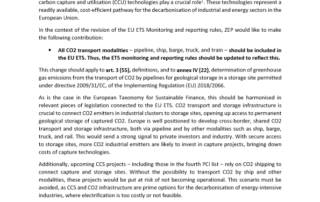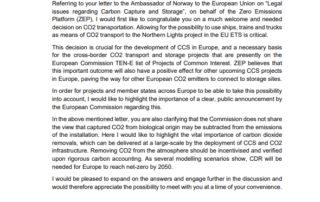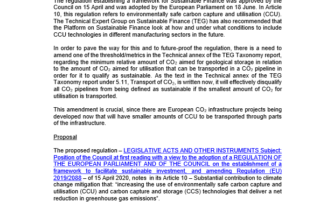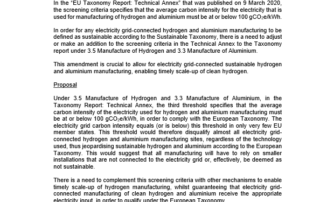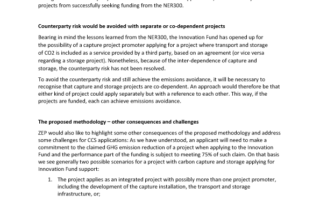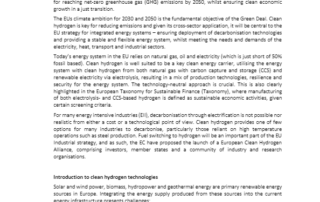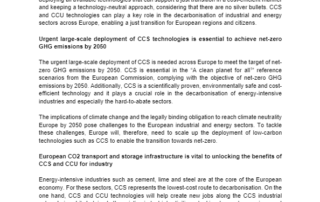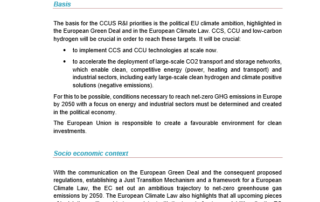How much CCS and CCU will be needed in 2030? – Objective: for Europe to be on track to reach climate-neutrality by 2050
A new political reality in EU and beyond with climate change at the heart. With the European Green Deal and European Climate Law, the European Union has increased its climate ambitions and formalised its support for the target of climate neutrality by 2050. Related to the European Climate Law, the European Commission has recently proposed to increase the current 2030 greenhouse gas (GHG) emissions target to reflect the increased climate ambitions of the EU. The Commission’s proposal – currently in negotiation with the European Parliament and Member States – outlines a plan to increase EU GHG emissions reduction target to at least 55% compared to 1990 levels by 2030 within the European Union. The increased EU ambition for GHG emissions reduction by 2030 will make the role of CCS even more critical and the large-scale deployment of CCS within the 2020s becomes crucial to support the climate ambitions of the European Union.
ZEP letter to DG CLIMA on CO2 shipping in EU ETS
ZEP letter to DG CLIMA on CO2 shipping in EU ETS - ZEP highlights that allowing for the possibility to use ships, trains and trucks as means of CO2 transport to the Northern Lights project in the EU ETS is critical. This decision is crucial for the development of CCS in Europe, and a necessary basis for the cross-border CO2 transport and storage projects that are presently on the European Commission TEN-E list of Projects of Common Interest. ZEP believes that this important outcome will also have a positive effect for other upcoming CCS projects in Europe, paving the way for other European CO2 emitters to connect to storage sites.
Input to DG CLIMA on the Innovation Fund – challenges for CCS projects and lack of alignment with the Taxonomy
The Zero Emissions Platform (ZEP) would like to thank the European Commission for a transparent process leading up to the planned first call of the Innovation Fund. ZEP appreciates the opportunity to provide feedback and engage with DG CLIMA at the Expert Group meetings, as well as in bilateral meetings, and is thankful for the timely updates provided at the ZEP Advisory Council meetings and network meetings. ZEP has provided input to DG CLIMA to highlight some issues that arise in the current state of design of the Innovation Fund, which ZEP believes are considerable and could have negative effects on the possibility to reach the EU target of net-zero GHG emissions by 2050.
Future-proofing the Taxonomy regulation regarding CO2 transport infrastructure
Challenge: The current Taxonomy screening criteria disqualifies the entire CO2 infrastructure even if only the smallest amount of the CO2 is aimed for utilisation. Background The regulation establishing a framework for Sustainable Finance was approved by the Council on 15 April and was adopted by the European Parliament on 18 June. In Article 10, this regulation refers to environmentally safe carbon capture and utilisation (CCU). The Technical Expert Group on Sustainable Finance (TEG) has also recommended that the Platform on Sustainable Finance look at how and under what conditions to include CCU technologies in different manufacturing sectors in the future.
Making clean hydrogen and aluminium manufacturing eligible in the Sustainable Taxonomy
Challenge: The current Taxonomy screening criteria disqualifies grid-connected manufacturing of hydrogen and aluminium, regardless of the technology used. Background In the “EU Taxonomy Report: Technical Annex” that was published on 9 March 2020, the screening criteria specifies that the average carbon intensity for the electricity that is used for manufacturing of hydrogen and aluminium must be at or below 100 gCO2e/kWh. In order for any electricity grid-connected hydrogen and aluminium manufacturing to be defined as sustainable according to the Sustainable Taxonomy, there is a need to adjust or make an addition to the screening criteria in the Technical Annex to the Taxonomy report under 3.5 Manufacture of Hydrogen and 3.3 Manufacture of Aluminium. This amendment is crucial to allow for electricity grid-connected sustainable hydrogen and aluminium manufacturing, enabling timely scale-up of clean hydrogen.
ZEP Position Paper: A new long-term strategy for Europe’s industrial future
CO2 underground storage is a safe and mature technology ready for broad implementation, as evidenced by over twenty years of successful storage offshore in Norway, combined with more recent onshore storage in Canada and the USA. In Europe, CCS benefits from a clear set of regulations and requirements under the 2009 EU CO2 Storage Directive that ensure the identification of appropriate storage sites and the safety of subsequent operation.
Priorities on CCUS R&I activities
Areas of importance for R&I activities – input to DG RTD, European Commission (EC), by the Zero Emissions Platform (ZEP) and the European Energy Research Alliance (EERA) and with input from the CCUS SET-plan IMPACTS9 consortium.
Innovation Fund technical workshop – feedback from the Zero Emissions Platform
Zero Emissions Platform (ZEP) would like to thank the European Commission for the opportunity to be part of the technical workshops on 5 and 6 February. ZEP is delighted to see that the Innovation Fund has benefitted from the in-depth NER300 post-investment review. Among the many lessons learned, the most important one was that the difficulty arising from the counterparty risk due to the full value chain applications, hindered many CCS projects from successfully seeking funding from the NER300.

